Exploring “America’s Stonehenge” in New Hampshire
Touring One of New England’s Better-Known Stonework Sites
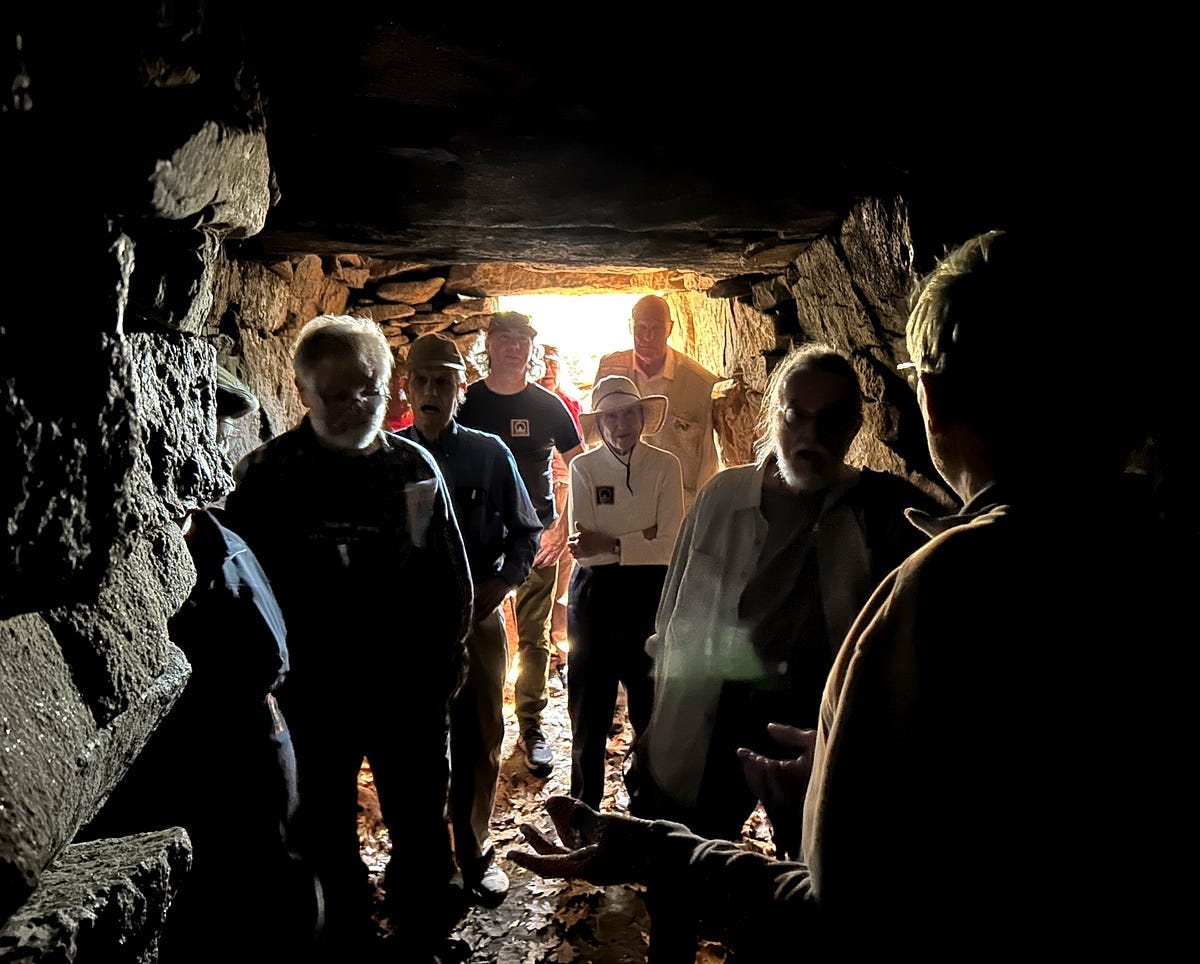
Touring One of New England’s Better-Known Stonework Sites
America’s Stonehenge is open to the public. Learn more at https://www.stonehengeusa.com/
The experience at the top of the hill is kind of… intense?
This has to have been something.
Doesn’t it?
Perhaps there’s some primitive instinct which sees so much stonework in such concentration and demands that it must be “something”.
Is that, perhaps, the mystery on this hill? The unconscious impact the concentrated sight of all this stonework has upon us? Triggering something deep within? Is that why some are stirred to such a sense of Wonder?
Whatever the cause, impacts reverberate still. The impression this place made on people — and continues to make —brought me to the site, an important piece in the larger tapestry of antiquarian pursuits and amateur archaeology in our region.
Fascinated by New England’s ancient stonework, Robert Stone first began leasing this hilltop property in the mid-1950s, and became the owner in the mid 1960’s. These days, his son Dennis Stone owns and oversees the unique stone site once known as Mystery Hill.
Dennis Stone is a gracious host and guide.He showed our group around the site, feature by feature, and discussed some of the ideas they’ve had about what the incredibly concentrated stonework there was used for, and some of their hypotheses on who may have built it, and why.
Stone entertained many questions and comments as our group worked our way through the stone features, admitting there were still more questions than answers, as any answers which came seemed to yield more questions. Keeping minds open to many possibilities, they continue to make new discoveries at America’s Stonehenge, and continue to uncover new understandings.
One of the more recent appreciations developed at the site is for what Stone calls “Windows” in some of the “Stone Walls”, deliberate gaps in the stonework, often found along with accompanying portable closure stones (some of us refer to these or similar such spaces in Stone Rows as “Niches”). Before we headed up the hill, we took a slight side-trip to see a low stone row with several “Windows” in it.
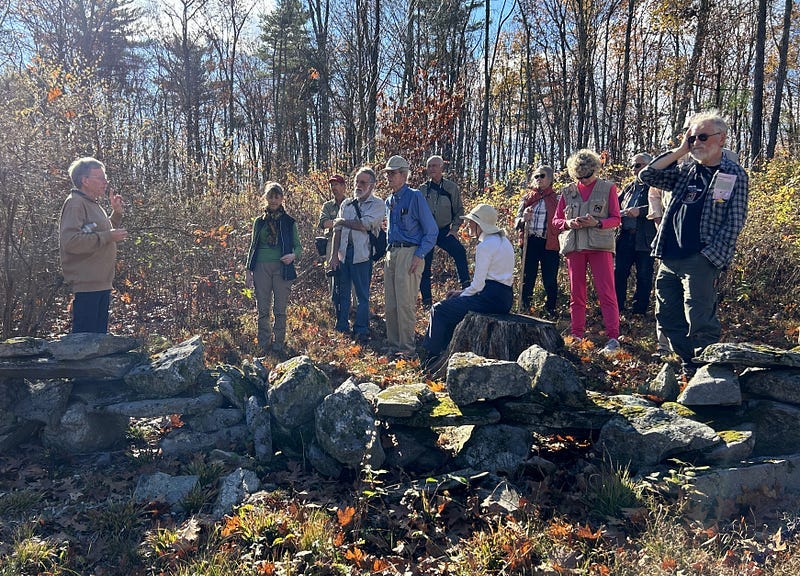

What is the significance of these niches or windows in a stone row? Some have suggested these were simply water gates, where water could flow through the wall in the Spring. Others suggest smaller animals might have used these, though the sheer number of the features may disprove this idea.
Another possibility is that this is an older, pre-agricultural stonework, and the gaps are aligned to significant Lunar or Solar Events. Though trees are now in the way, use of the SunSeeker App showed a potential for Summer Solstice Sunrise alignments with the horizon when viewed through the gaps. Or perhaps the first light from the Solstice Sunrise would have shone up through the gaps, up the hill.
These gaps can been seen in low stone rows, apparently older stonework, throughout the region. Their actual purpose seems to have been forgotten, as the agricultural “explanations” vary and contradict each other, and there are often potential sky alignments present, which perhaps suggest an older, more ritual or spiritual purpose in their design.
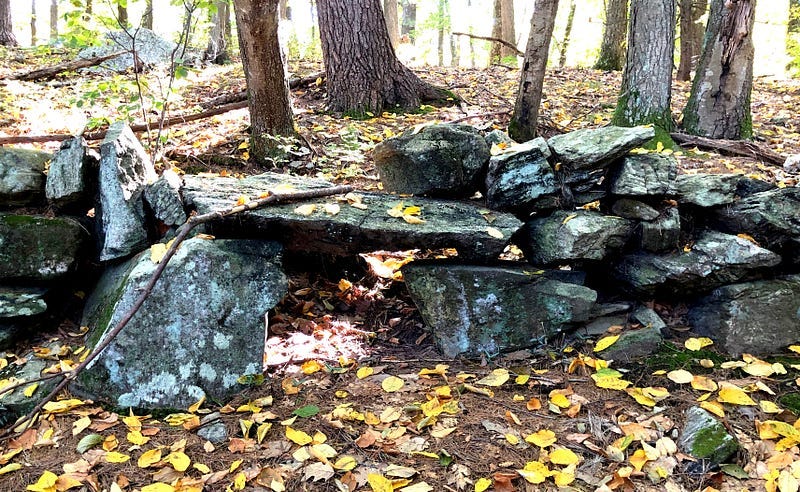
In some ways, these niches or windows may be some of the more interesting stonework here, historically speaking, as they seem to have remained intact over time, whereas much of the main site has been manipulated and rebuilt in various ways throughout the years.
My sense is that any outlying stonework at the site is more likely closer to its original state than anything up on the hill, though there has likely been some alteration to the outlying work as well. I’m encouraged that they’re looking into these “windows” in the outlying stone rows as they seem indicative of earlier stonework, left untouched by virtue of “hiding in plain sight.” And I have seen these sorts of niches or windows in what appear to be Indigenous stone rows elsewhere in the general region.
As our tour of the site continued, America’s Stonehenge’s General Manager James Lacefield caught up with the group. Both he and Dennis Stone were open to discussions, and seemed to attempt to approach speculation on the site with an open-minded regard in the moment. Visitors shared and compared many speculations on the stonework, and they engaged with folks’ ideas with patience and enthusiasm.
Having read and watched a few different assessments of America’s Stonehenge and its stonework, I was curious what my own reaction would be, what impressions I’d receive. This was my first visit and, despite what I’d heard or read before, I tried to approach the site with an open mind.
To my eyes, there appear to be several layers of creation and manipulation represented. It seemed likely the outer-lying stonework, like the old stone rows with their “windows”, was some of the oldest at the site. It’s likely there are several further Indigenous layers of stonework development atop and alongside this, followed by a layer of adaptation in the 17th — 18th century as settlers built using older stonework re-purposed. Then, there’s a later reconstruction layer, as antiquarians in the 1940’s and ‘50’s attempted to rebuild and restore what they found at the site.
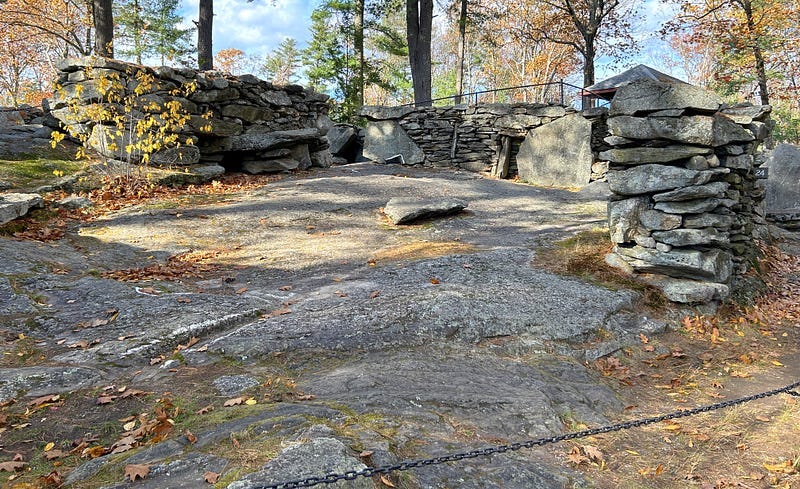
The predominant work on the hill — especially the top — struck me with a sense of artifice — the look akin to the Stone Follies stone masons build in the gardens and backyards of wealthy clients: fanciful castle walls, spirals, mazes and faux-medieval courtyards. It’s awesome, but… there is an artifice to it.
Yet, all around, sort of underneath the presumed later layers, there were other elements which appeared to be remnants of authentic, older work, shining through.
The Watch House Chamber is built into a Stone Row on the way up the hill, built up off of an anchoring boulder. Dennis Stone suggested it could be the head of a Serpent and part of a Serpent Wall, pointing out Undulations in the Stone Row leading away from it and up the hill.
Though it was likely later used for many purposes over time, the style of the construction of this Stone Chamber and it’s possible Serpent Row-context leads me to believe it could be one of the older stone constructs on the site, and originally of Indigenous origin.
The construction style of the Watch House Stone Chamber is visibly different from what we see just a bit further up the hill. Especially as the first area we see on the hilltop is the Pattee Area, where the family who settled this hill used the stonework for foundations and storage.
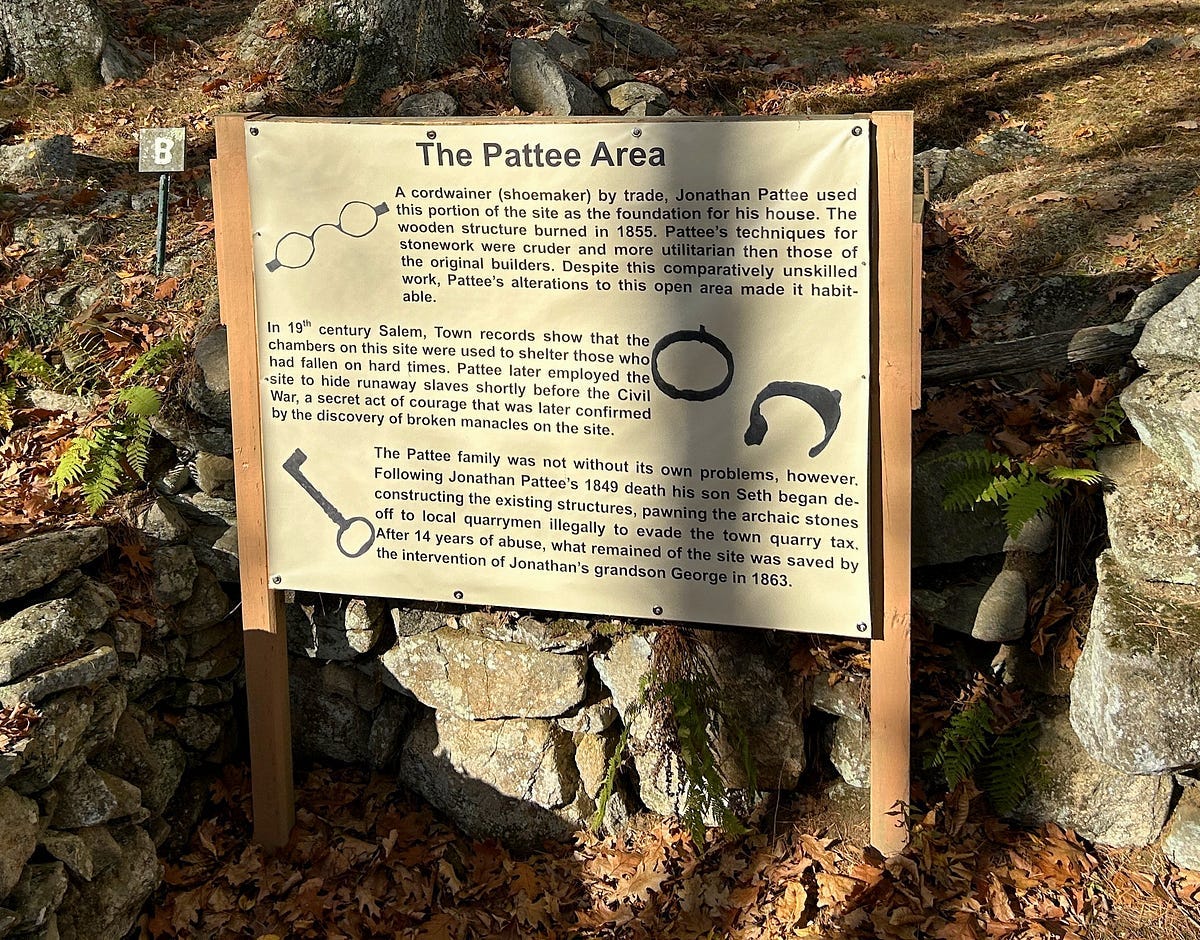
What must it have been like to live here, day-to-day, amidst all this stonework? What did the Pattee House look like? Why does it look like the Pattees adapted something older that was here before them? What was here before them? How much of the original stonework did Seth Pattee sell off? So many questions to which we don’t really have answers.
It’s likely they also changed or built some of the stonework beyond this area, higher up on the hill, as local records mention they had poor folks staying up in their old “caves”. It’s also said the site was used to hide people fleeing enslavement on the Underground Railroad prior to the U.S. Civil War.
I tried to picture normal people, average folks, doing normal things here — with some degree of success. But I couldn’t quite shake an underlying sense of strangeitude that rendered such mundane thoughts a little absurd.
Above the Pattee Area, we come to the hilltop and the heart of the stonework at the site, with several Stone Chambers, including The Oracle Chamber, as well as the so-called “Sacrificial Table”. Though the amount of restoration performed by well-meaning antiquarians in the mid-20th Century is disputed, they did do some rebuilding work in this hilltop area.
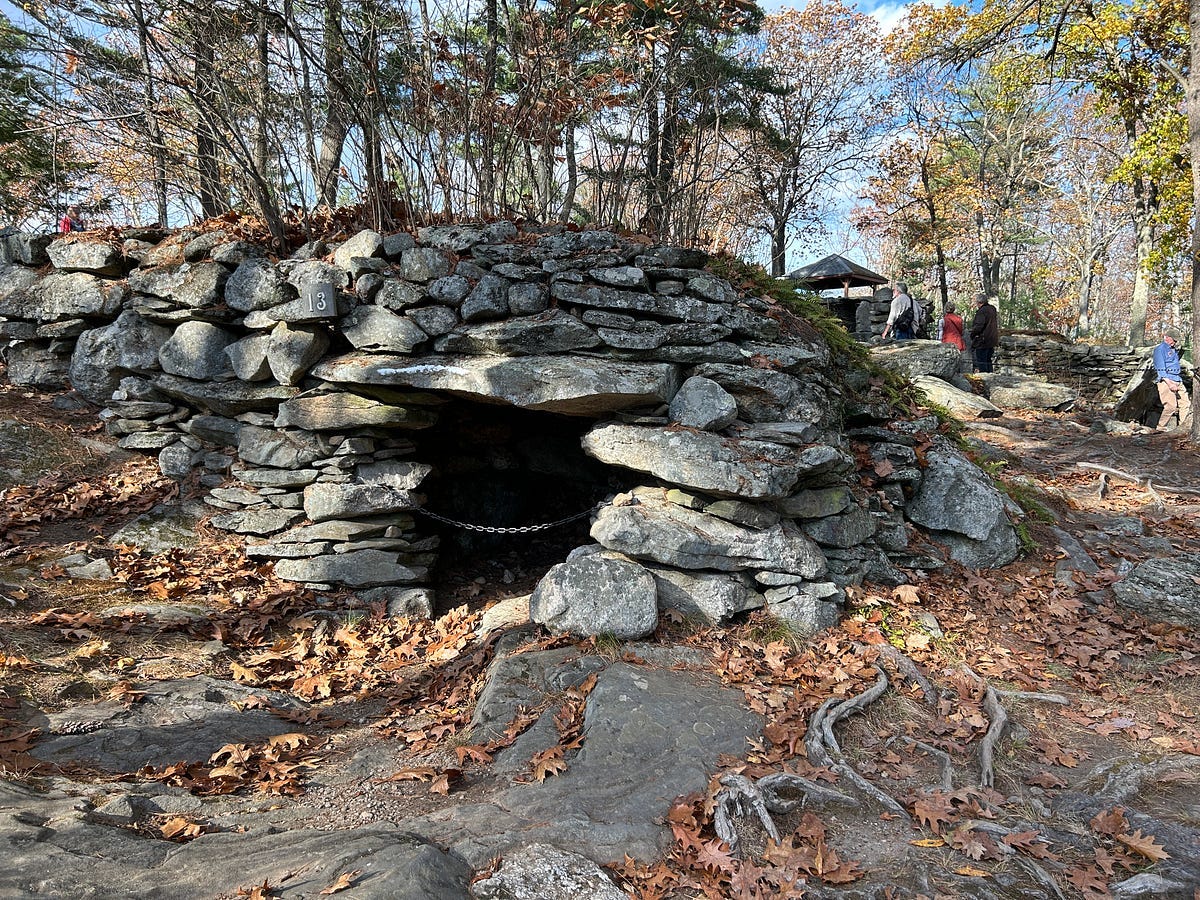
Notable 19th-20th Century Antiquarian William B. Goodwin was a retired insurance executive, an amateur archaeologist, and the owner of this site later known as America’s Stonehenge for a time in the early-to-mid 20th century, in the years before the Stone Family acquired it.
Though Stone tends to present a positive assessments of Goodwin, one of the problems with trying to figure out who built the stonework at America’s Stonehenge and when they built it is that Goodwin had some controversial “Restoration” work done to the hilltop stonework in the 1940’s when he owned the property. He and Malcom Pearson restored stonework which had fallen down into disrepair. Pearson would later come to own the site after Goodwin, just before the Stones.
How much did Goodwin and Pearson change the stonework? Accounts vary. The degree to which they rebuilt the site is disputed, with some saying they engaged in wholesale reconstruction and others insisting the amount of work done was exaggerated. There’s also argument on the degree to which Goodwin’s original hope that the stone constructs were ancient Irish ruins influenced the rebuilding.
I was somewhat familiar with the controversies surrounding Goodwin’s reconstructions at America’s Stonehenge prior to my visit to the site. After seeing the site firsthand, their well-intentioned if misguided work seems to stand out in two ways:
First, in the squared-off edges and flat tops of the stone walls and other assemblages near the hilltop — Western or European inspired stonework appears generally flat and orderly and often mimics the 1-over-2 coursework of brick or block work. Indigenous Stonework generally appears more organic and flowing, its coursework more dictated by its design.
Second, which I think speaks to their supposed good intentions — in some places we see organic coursework “tamed”, so to speak, and some of the original, flowing design still lingers in the now squared-off, restored stonework. In this, it would seem an attempt was indeed made to simply lift the stones from where they fell and place them back up into their proper places, as if re-assembling a puzzle, as some contend Goodwin and Pearson did.
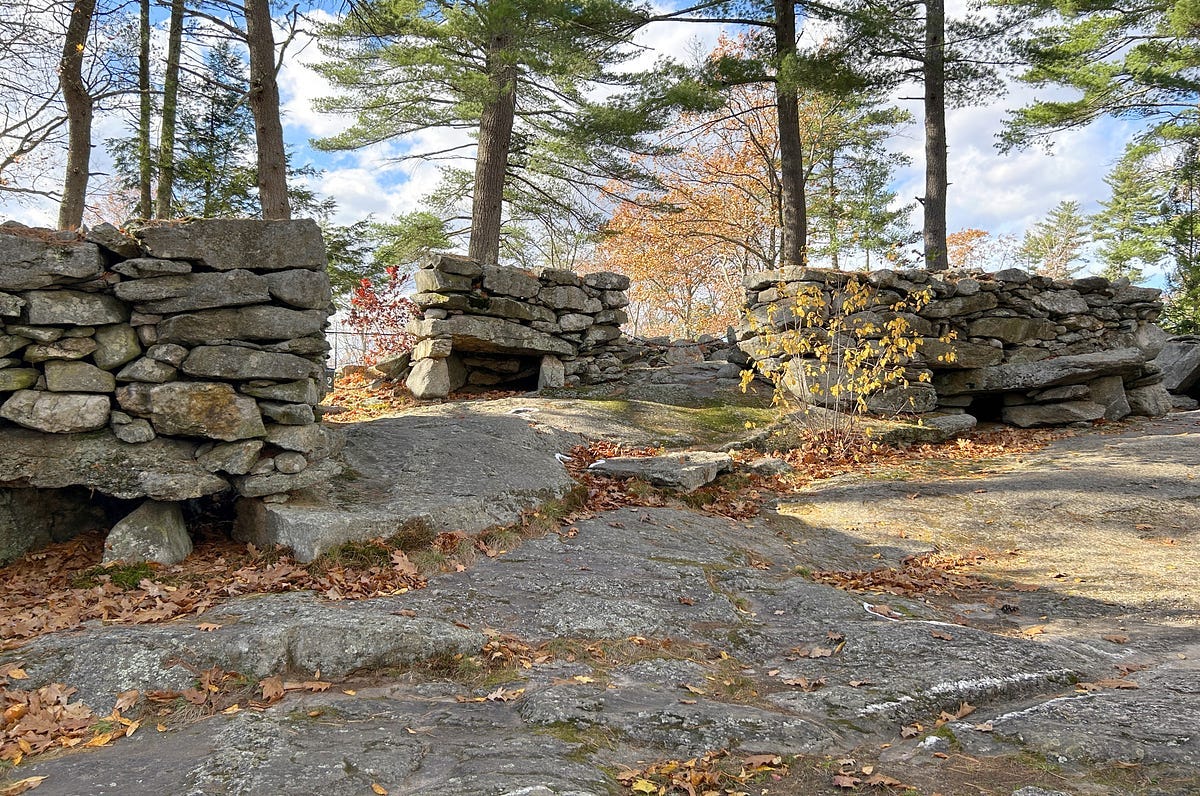
But the overall squared-off, flat construction serves as its own sort of physical manifestation of the limitations inherent in their perceptions of the site.
There are also some somewhat dubiously placed “Standing Stones” on the hill which appear to have benefited from reconstruction with a Eurocentric interpretation of where they “belong”.
But this is not to suggest that all stood-up stones at the site are necessarily late additions, and certainly not the ones in stone rows outside of the hilltop area, which are likely what’s left of some of the older layers.
That most recent layer, though… It almost feels like too much. Like they did too much then for us to see past it now.
And, yet… still… despite this?
It seems like you can see past their restoration work, in some instances. There are older layers, still visible in the background, in places. The restoration work was also focused on the hilltop, which is why the more-outlying stonework is likely less altered.
Given the disturbances caused by the reconstruction here, however, I’m not sure mainstream archaeology and anthropology will ever be willing to attempt to look past that late work to determine any older provenance to the stonework at this site. That doesn’t slow the research efforts of Dennis Stone and his people. Research into the origins of the stonework here continues.
Public interest in the site hasn’t waned. Three school buses were carting away kids from a field trip as our group was arriving for our tour. School field trips come through regularly, General Manager James Lacefield told me, though he said this one was likely the last of the fall season. Although, it was 70 degrees that November 1st, making it difficult to conceive of the day as a step towards Winter.
Wandering the site, the weirdly warm weather recalled H.P. Lovecraft, “…The autumn heat lingered fearsomely…” — from Nyarlathotep — and I recalled the work of a researcher or two who’d suggested Lovecraft could have been here. Maybe? A somewhat remote possibility…
The rest of Lovecraft’s story, even that sentence, didn’t bode well, “…and everyone felt that the world and perhaps the universe had passed from the control of known gods or forces to that of gods or forces which were unknown.”
Which, I suppose, brings us to the “Sacrificial Table”…

The flat, rectangular stone has been stood up horizontally like a table, the upward-facing side inscribed around its surface with a deep groove, parallel with the outer edge. One short side abuts the wall of a stone chamber, the other three sides are open.
Hidden beneath the short Chamber side of the table is the slightly flared opening to a small, squarish passageway that cuts through the entire thickness of the chamber wall. It’s said that when someone inside the chamber speaks into the passage, it’s carried, some say amplified, by the properties of the passageway to those outside around the table, who’d hear you as some kind of disembodied voice.
That’s why they’ve named the abutting stone chamber The Oracle Chamber. In the photo at the beginning of this piece, you can see Dennis Stone describing this aural illusion to our group while standing next to the passageway inside of the Oracle Chamber.
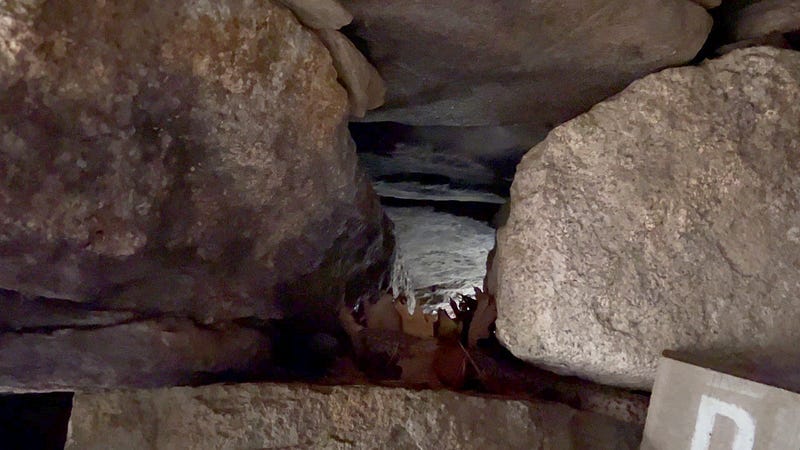
We couldn’t see this voice trick demonstrated, unfortunately, as they no longer allow visitors to approach the Grooved Table up close, after a vandal damaged the stonework a few years ago. A misguided, attention-hungry, religious and political extremist, some self-appointed QAnon savior, took it upon themselves to “do something” about — i.e. damage, ruin, or try to destroy — something which was supposedly a Satanic symbol in their conspiracy-minded little brain.
America’s Stonehenge did a good job restoring the stonework, based on what we could see. There was little sign of the vandalism remaining.
The Oracle Chamber is a large, T-Shaped Stone Chamber. The small voice passageway is roughly in the center of the top crossbar of the “T”. This “top crossbar” passage is open on the left side of the “T”, to an entry alcove, but closed-ended on the right. A now-open but once shuttered vent is open in the chamber roof above the closed right end.
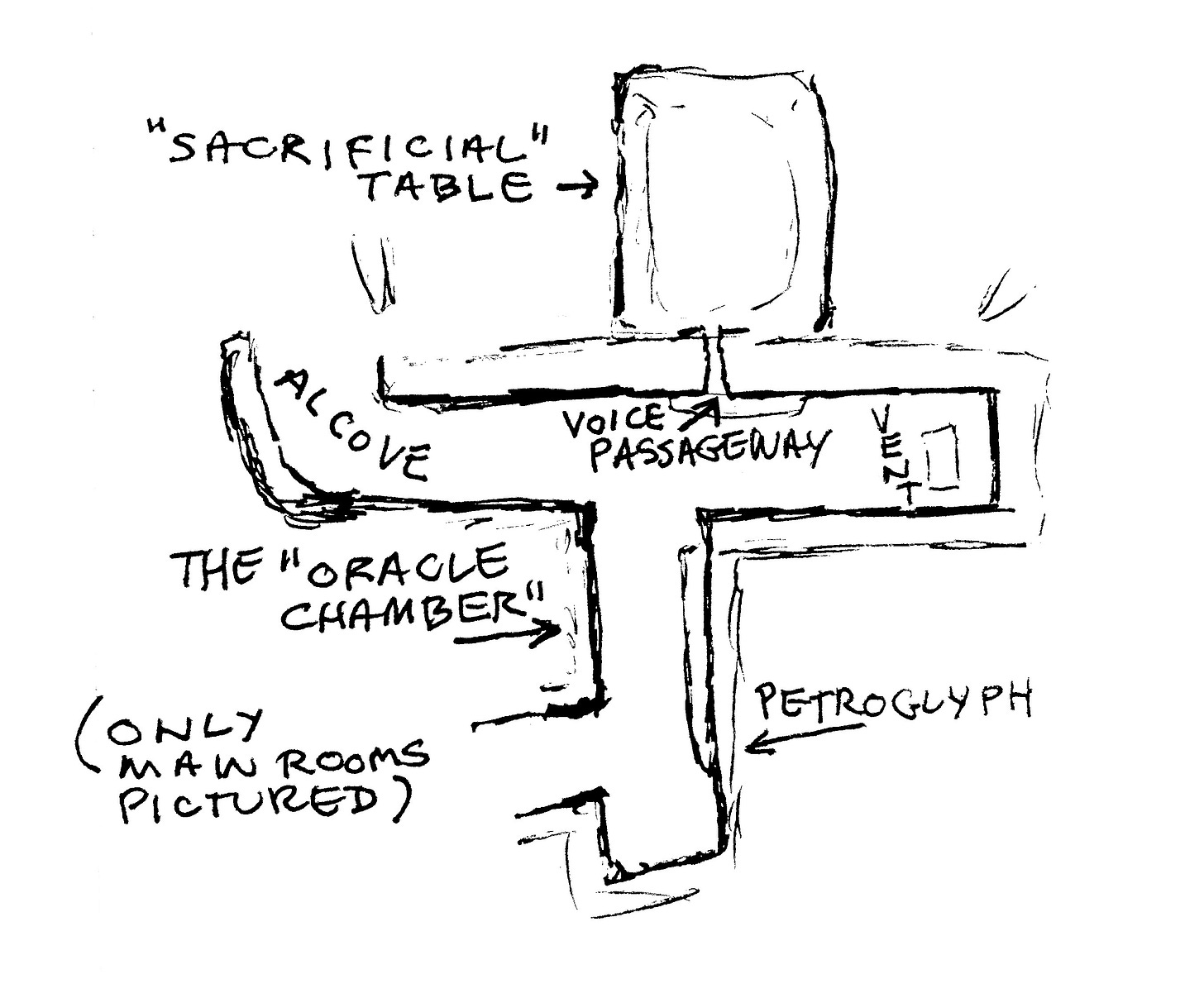
Several small alcoves or niches are built into the chamber, along the top crossbar passage and at the end of the lower passage, whose exit is on the lower left side of the descending bar of the “T”. Also of note, there is a petroglyph, now highlighted, on a stone in the chamber wall opposite the lower passage exit.
On the hilltop next to the Grooved-Top Table and Oracle Chamber, a Viewing Platform has been built so that visitors can look out around the hilltop and see the Alignment Stones and the proposed Solar and Lunar Alignments seemingly present in the encircling stone rows.
These apparent alignments using stonework inspired the name America’s Stonehenge — the idea wasn’t that the stonework here looked like the stonework at the original Stonehenge, but rather that it functioned in an astronomical sense in a similar fashion as the stonework at the original.
Though I’m not a fan of using European terms to describe possible Indigenous work, I can understand how the name serves as an explanatory shortcut describing the site’s larger function. And given the hilltop’s restored and reconstructed — and blended — history, maybe it’s best not to worry too much about what it’s called, especially if the name keeps the visitors coming and paying the bills, and allows Stone and company to keep preserving the stonework here, whoever put it together.
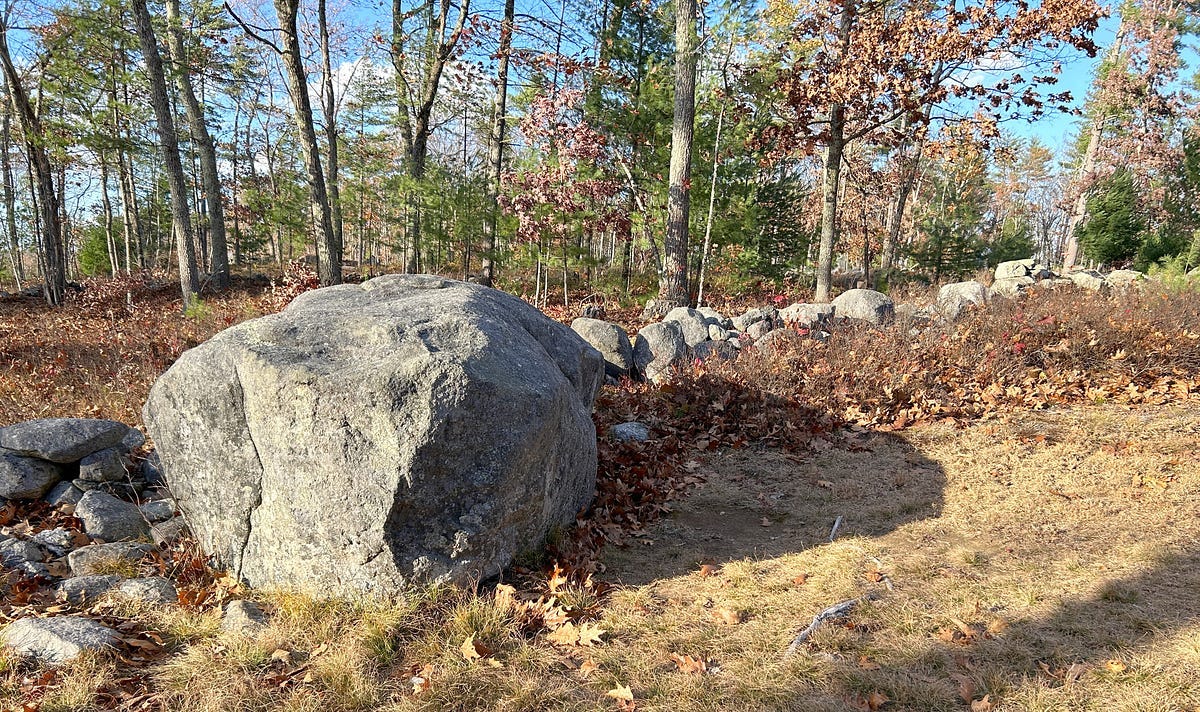
Earlier in 2024, Dennis Stone released a book of his own on the history of the site, America’s Stonehenge: The Stone Ruins of New Hampshire, with James Lacefield and Katherine Stone. I’ve not yet had the chance to read it, but look forward to doing so. Dennis was a great guide who obviously knows the site inside and out. Once again, he deserves enormous thanks for his gracious hosting.


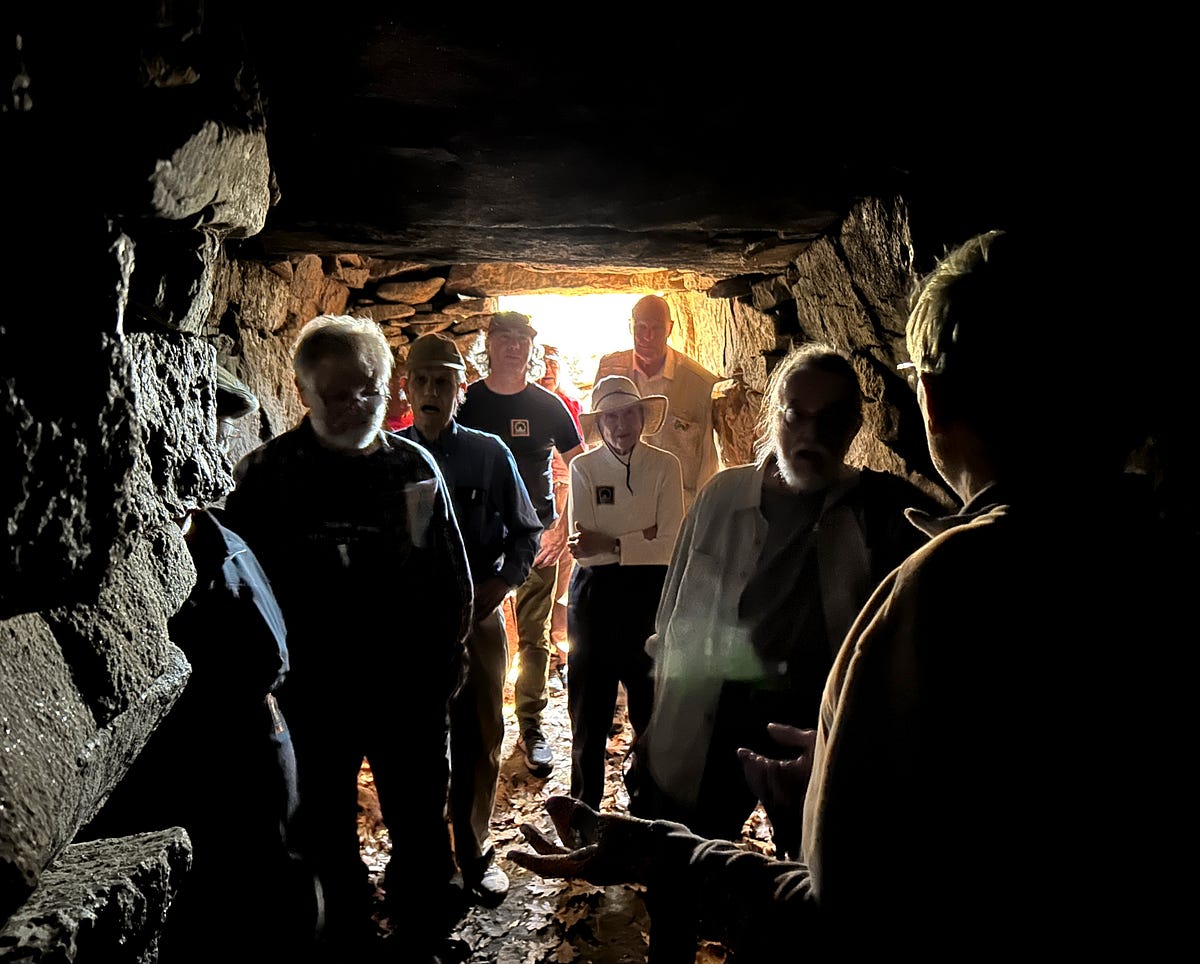


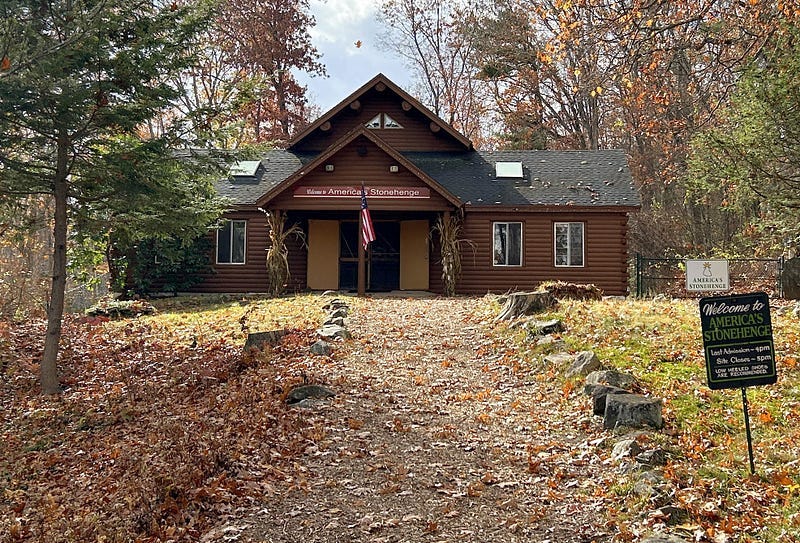
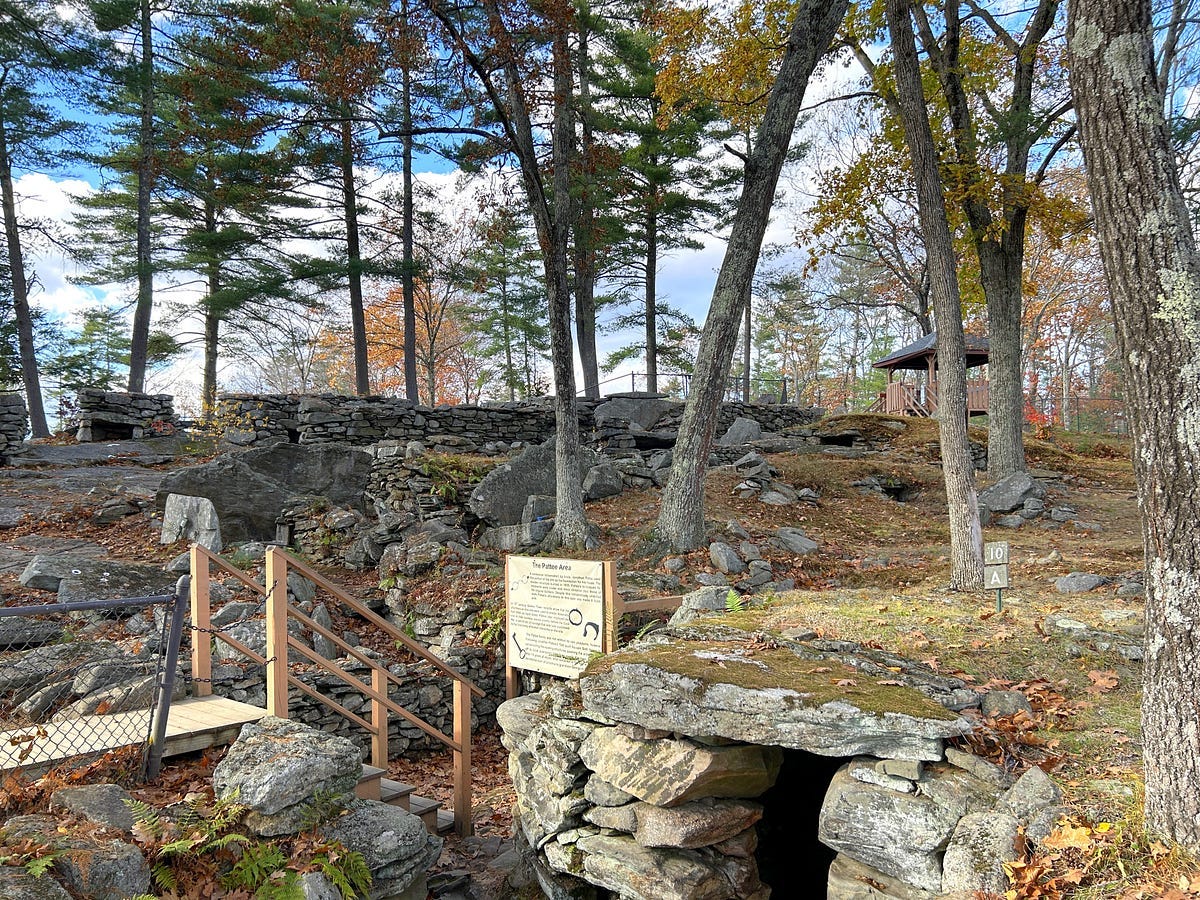
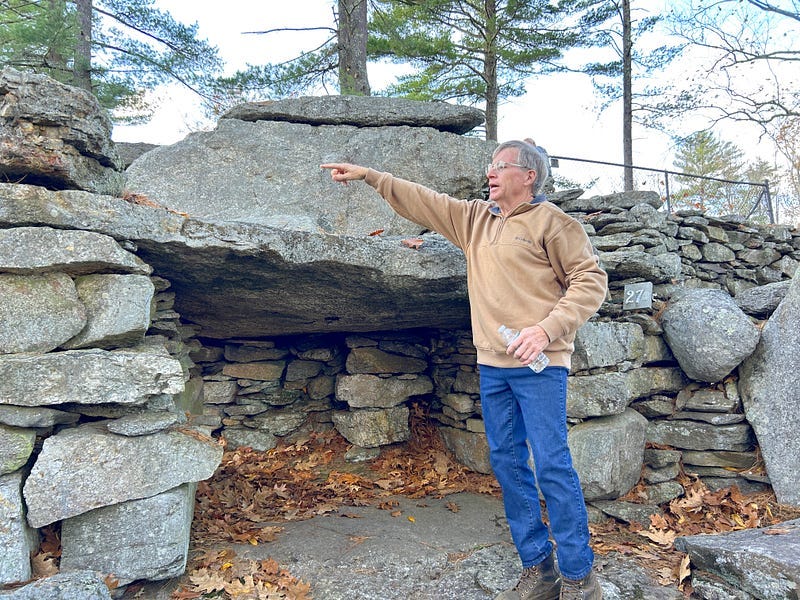

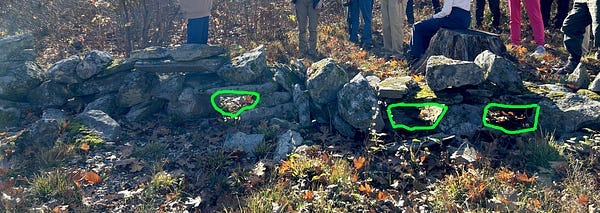
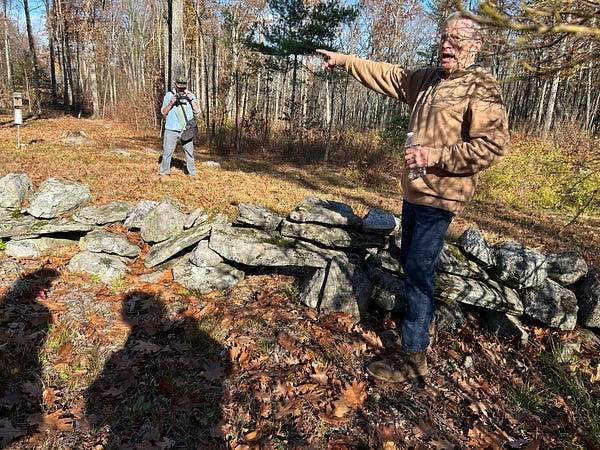


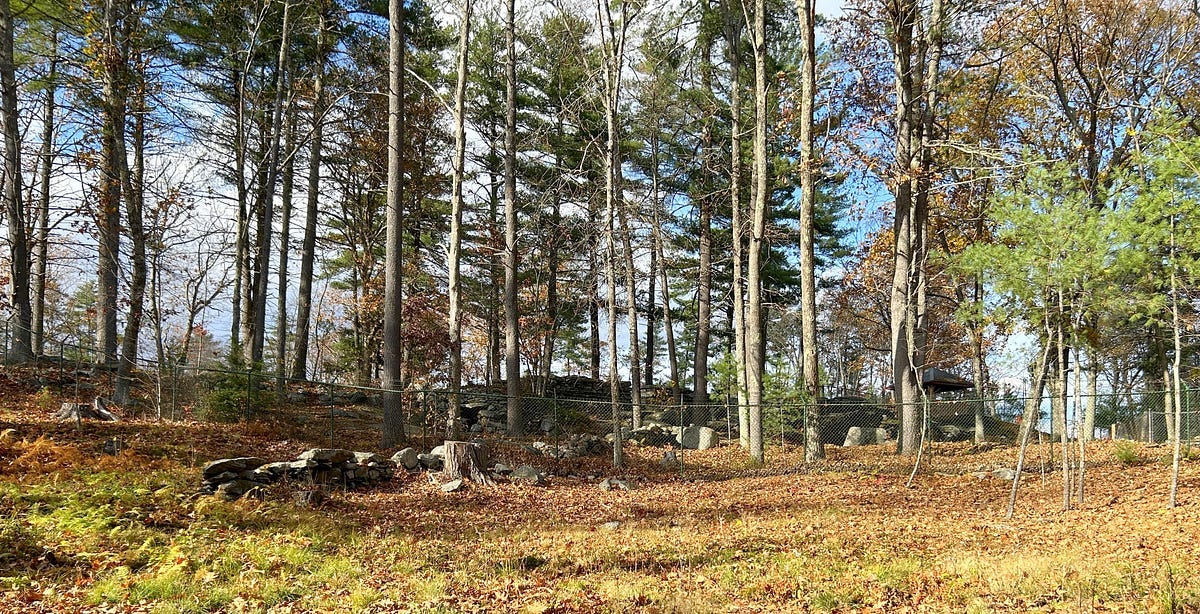
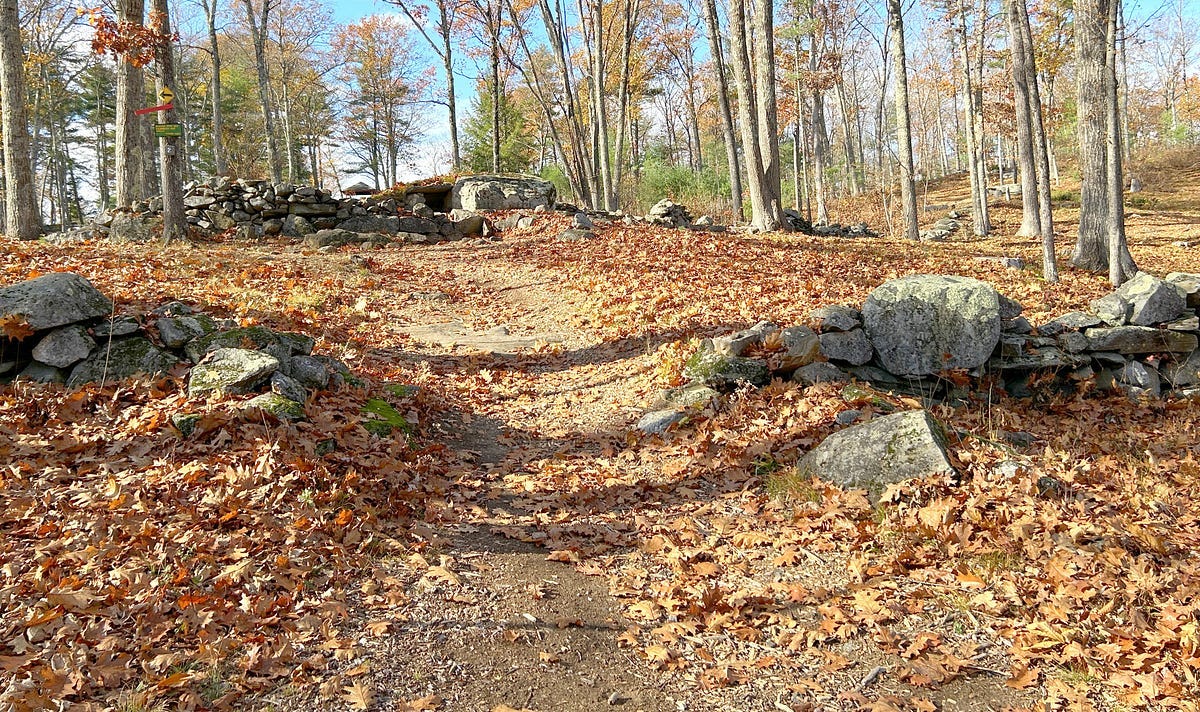
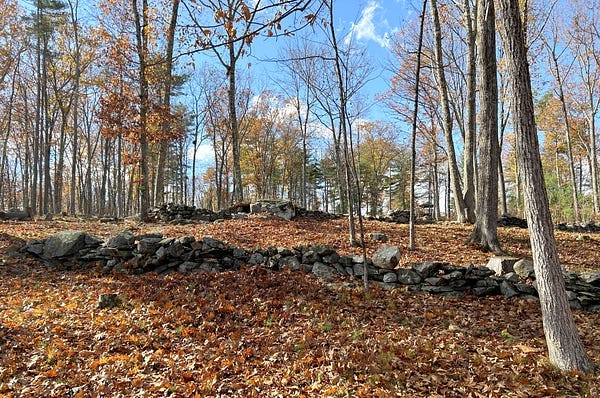
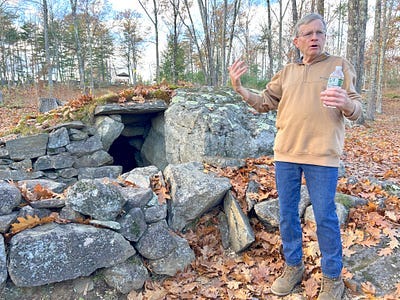

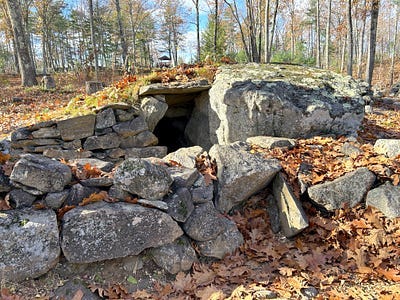
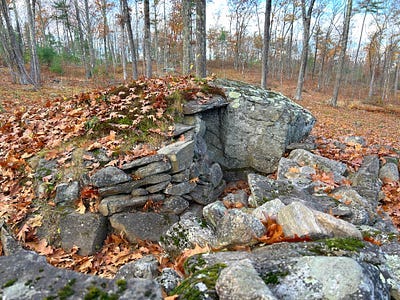
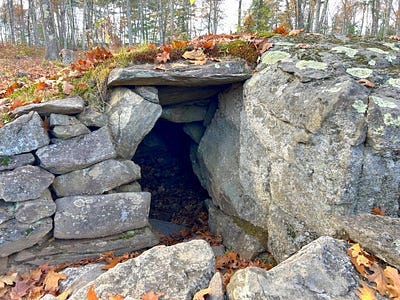
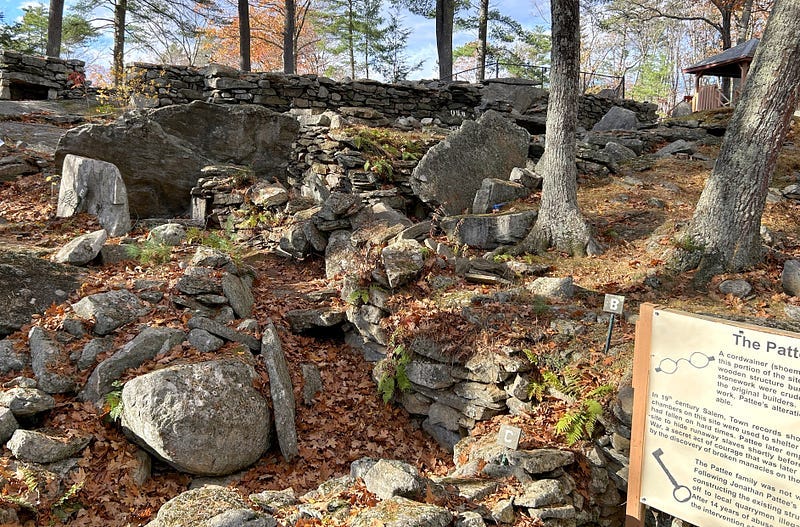
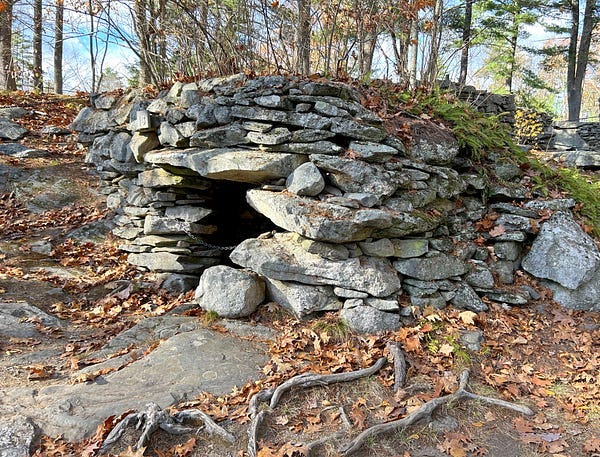
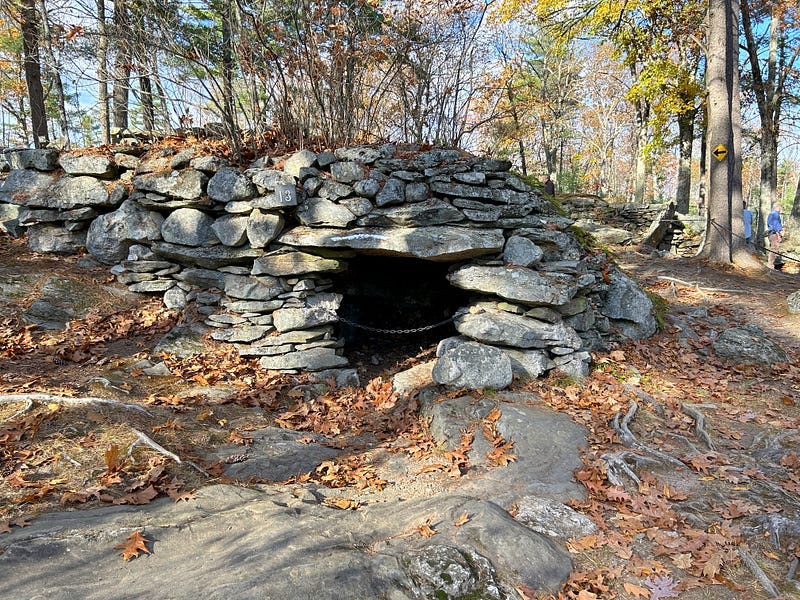
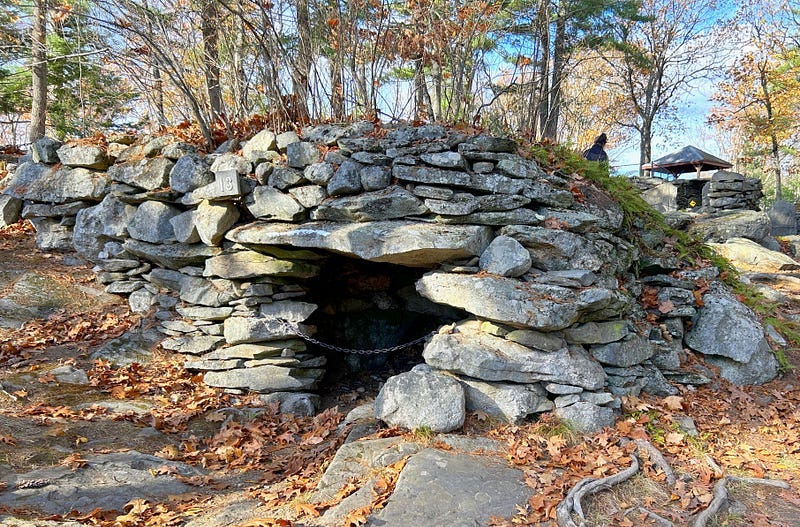
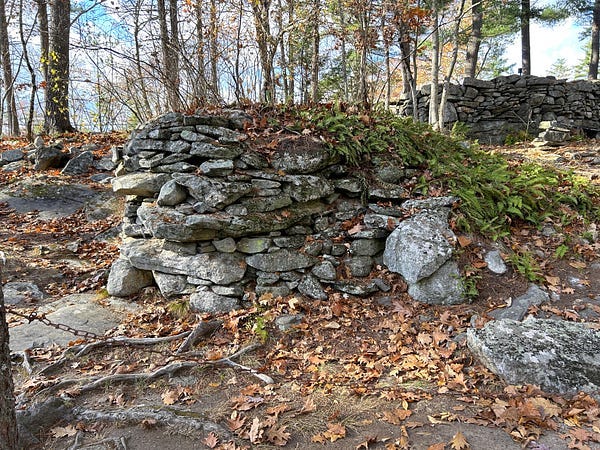

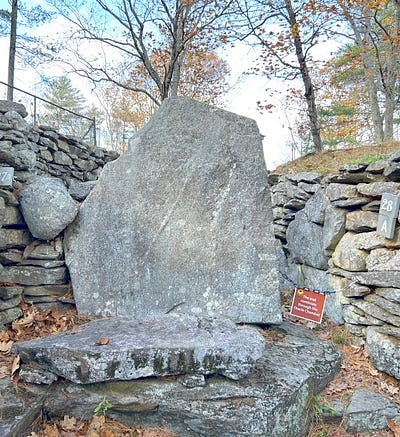


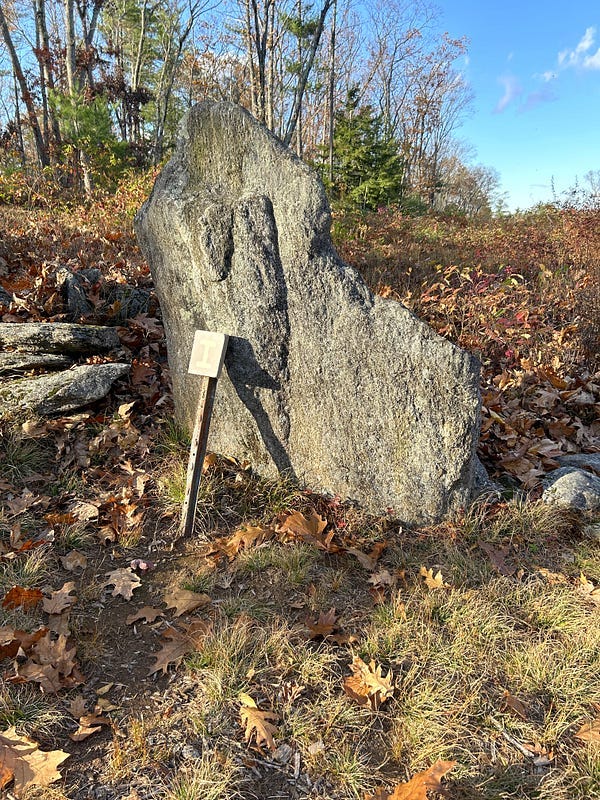
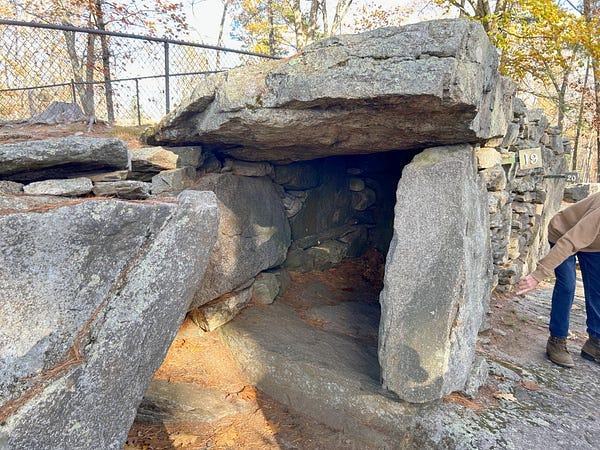
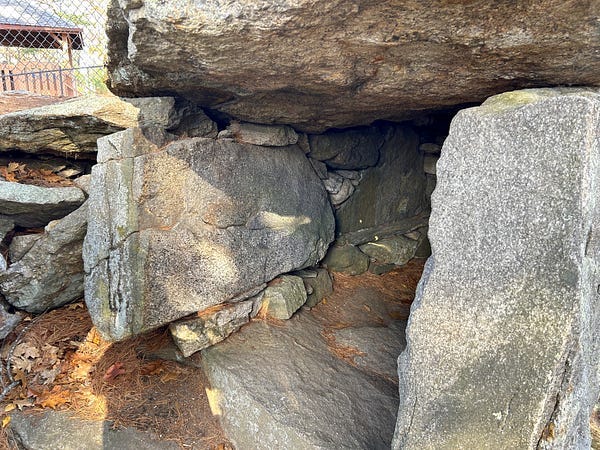
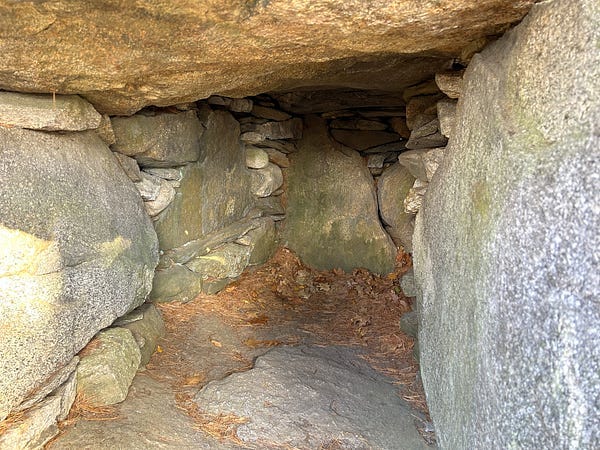
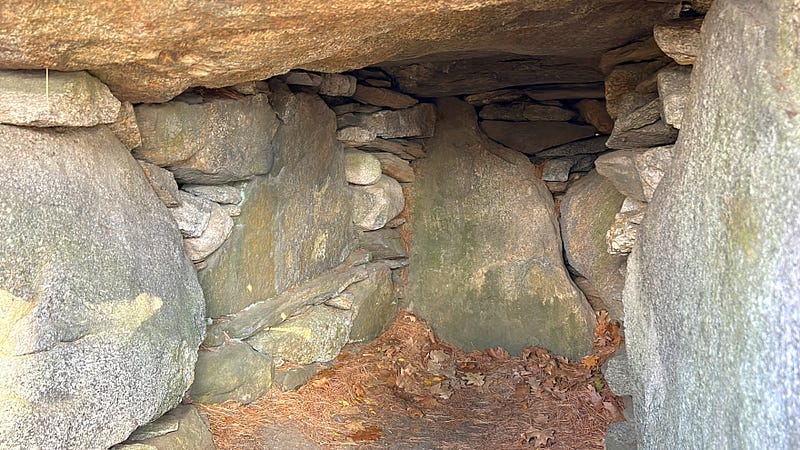
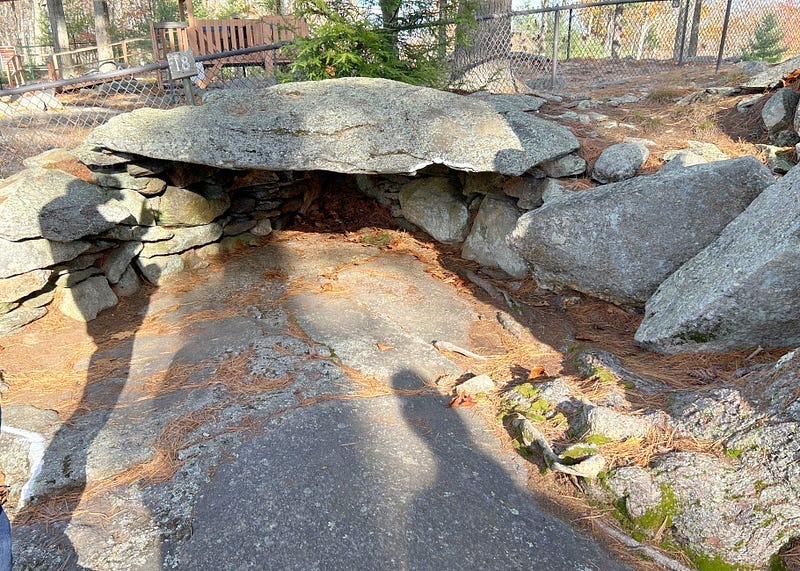
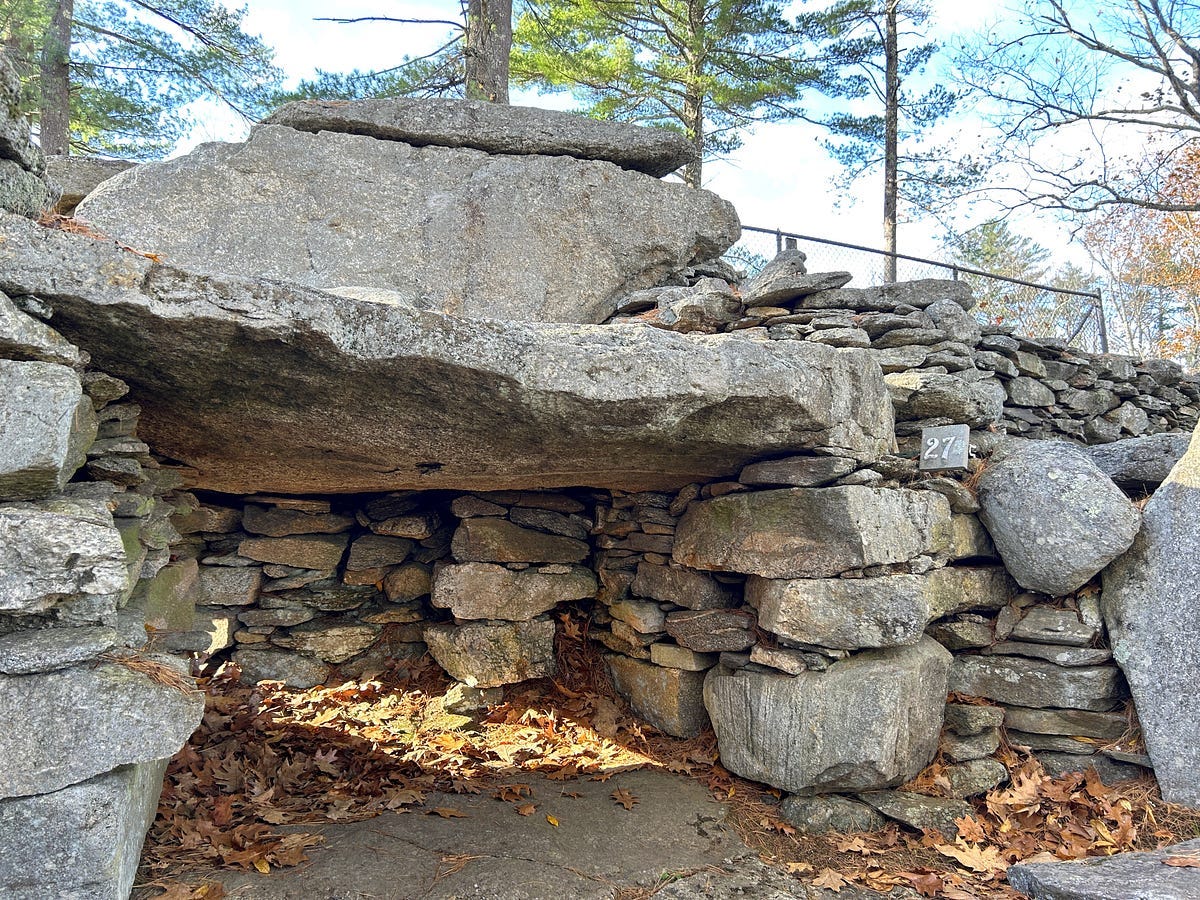
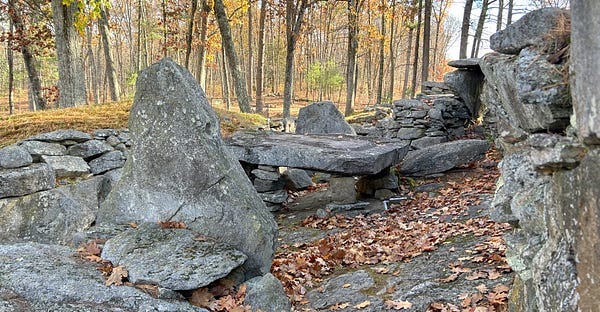
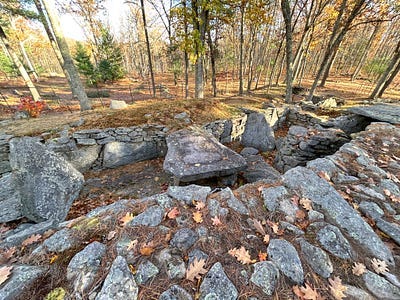
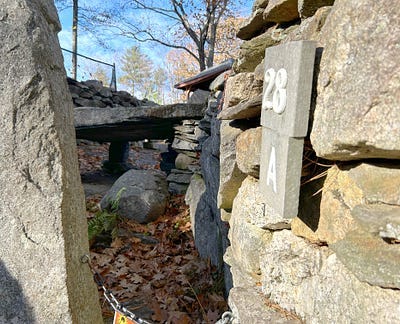

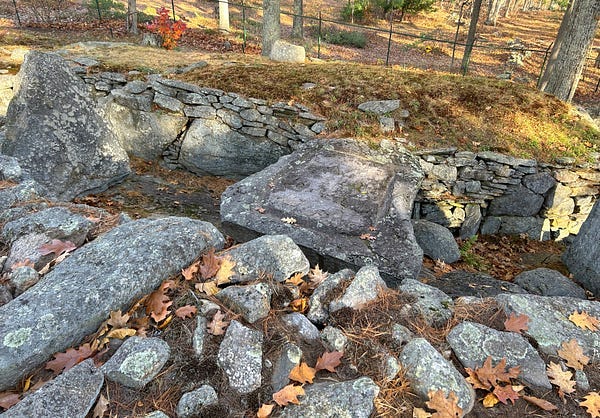
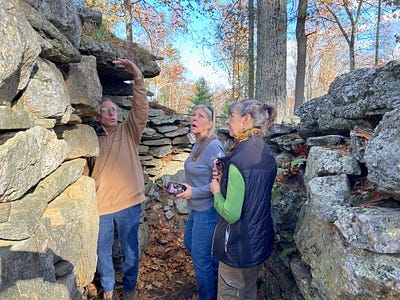
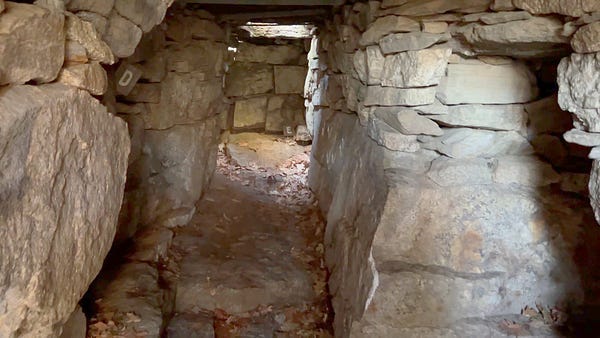
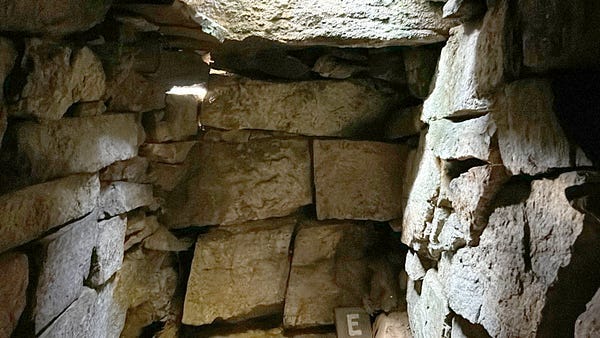
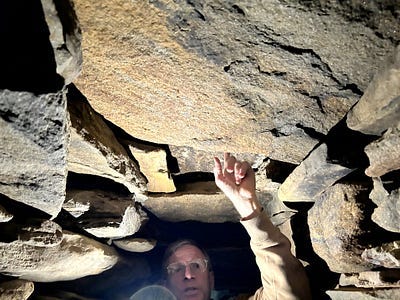
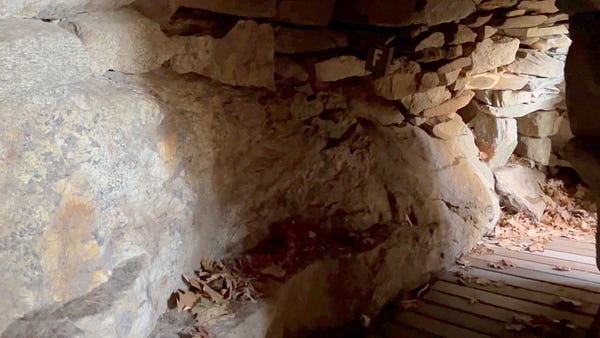

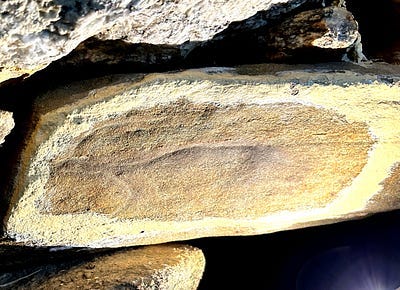
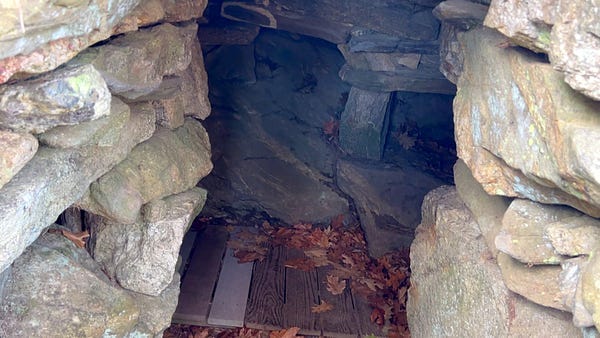
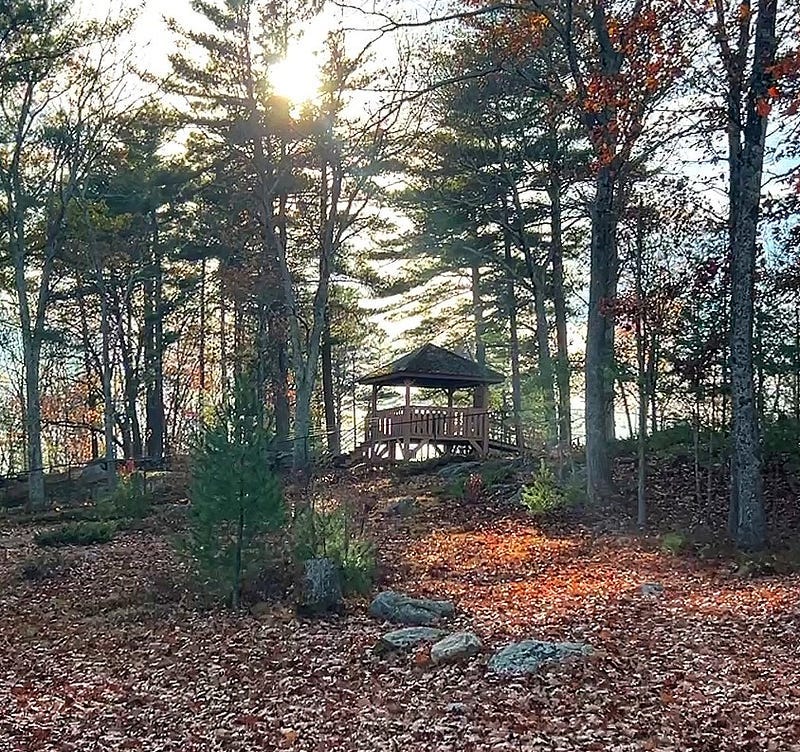
What I found extremely fascinating was on the huge bare stone ledge that a lot of the chambers were built upon had long grooves carved or ground into the stone surface winding around and away from the chambers to direct rain water away from them into the small pond. That was pretty interesting. Makes me wonder what the ledge here at home looks like if wasn’t buried with rotten leaf matter and muck.